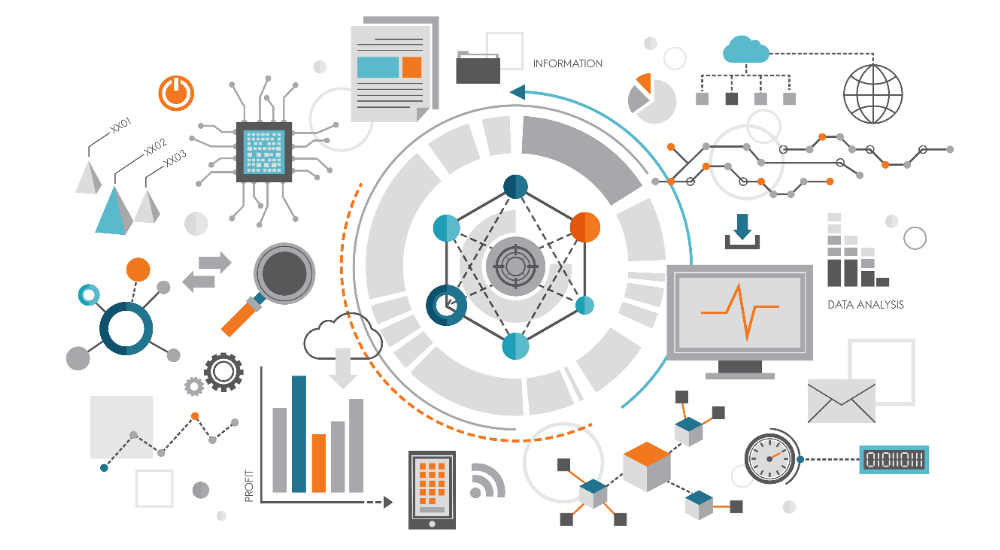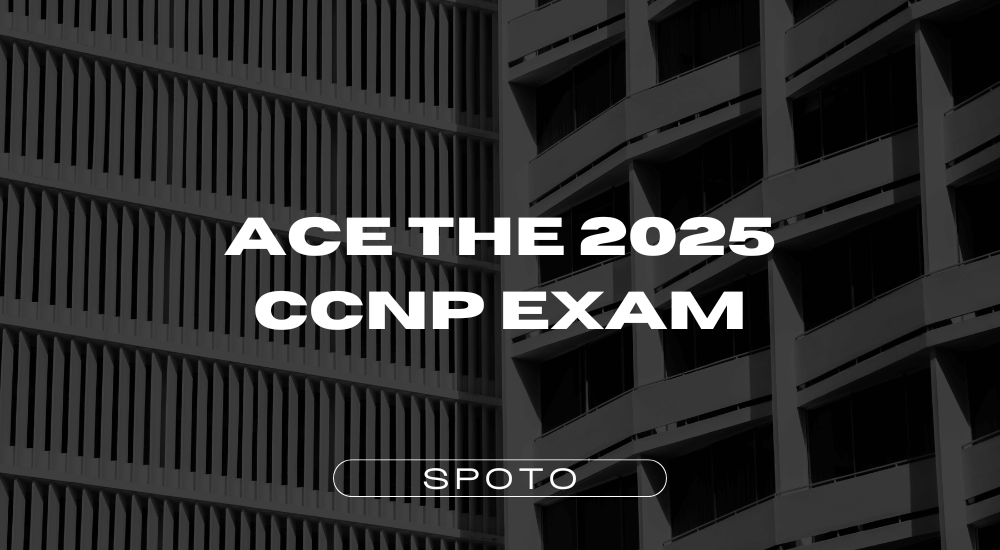TRUSTED BY THE SMARTEST TEAMS IN THE WORLD FOR CERTIFIED CANDIDATES
SPOTO Blogs
Useful learning materials to become certified IT personnel
-
- 906
- circle
- 2025-02-08 10:44
-
- 1278
- circle
- 2025-02-07 11:49
-
- 1380
- circle
- 2025-02-05 14:57
-
- 1450
- circle
- 2025-02-05 13:15
-
- 2905
- circle
- 2025-02-05 11:15
-
- 1367
- circle
- 2025-02-02 11:30
-
- 1039
- circle
- 2025-01-29 15:13
-
- 1746
- circle
- 2025-01-26 11:28
-
- 1179
- circle
- 2025-01-22 11:13
TRUSTED BY THE SMARTEST TEAMS IN THE WORLD FOR CERTIFIED CANDIDATES
SPOTO Blogs
Useful learning materials to become certified IT personnel
-
- 906
- circle
- 2025-02-08 10:44
Table of Contents1. Master the CCIE SP Exam Blueprint2. Gain Hands-on Experience with Labs3. Develop a Network Design Mindset4. Master BGP and MPLS Like a Pro5. Sharpen Your Troubleshooting Skills6. Get Comfortable with Network Automation7. Choose Study Materials That Match Your Learning Style8. Engage with Networking Communities9. Take Mock Labs Before The Real Exam10. Maintain a Balanced Study RoutineFinal Thoughts: Is CCIE SP Worth It? Earning the CCIE Service Provider (SP) certification is one of the most challenging achievements in networking. It requires deep expertise in MPLS, BGP, QoS, VPNs, and large-scale network infrastructure. However, with the right strategy and mindset, you can tackle this challenge effectively. Here are 10 pro tips to help you stay on track and succeed in the CCIE SP journey. 1. Master the CCIE SP Exam Blueprint Before diving into study materials, take the time to carefully analyze the CCIE SP exam blueprint provided by Cisco. This test spans multiple critical areas, such as: MPLS (Multiprotocol Label Switching) BGP (Border Gateway Protocol) and Routing Policies Segment Routing and QoS Service Provider VPNs (L2/L3 VPNs) Traffic Engineering and Network Automation Breaking the blueprint into smaller study objectives allows for targeted learning and ensures that you develop a strong grasp of every required skill. 2. Gain Hands-on Experience with Labs The CCIE SP exam isn't just about theory—it demands practical expertise in real-world network configurations. Hands-on practice with MPLS networks, BGP peering, and traffic engineering is crucial. Set up virtual labs using GNS3, Cisco Modeling Labs (CML), or EVE-NG. Work on BGP route reflectors, MPLS VPNs, and QoS mechanisms. Simulate different network failures and troubleshooting scenarios. If you can confidently build and troubleshoot an ISP network from scratch, you're on the right track. 3. Develop a Network Design Mindset Unlike other CCIE tracks, CCIE SP requires expertise in designing scalable and resilient service provider networks. Your focus should be on: Understanding the differences between Tier 1 ISPs and enterprise networks. Exploring ways to scale BGP with thousands of routes. Learning how MPLS Traffic Engineering (MPLS-TE) enhances network efficiency. Studying real-world ISP architectures and analyzing Cisco's service provider case studies will give you deeper insights into best practices. 4. Master BGP and MPLS Like a Pro BGP and MPLS are the foundation of CCIE SP, so a deep, working knowledge of these protocols is essential. You'll need to be well-versed in: BGP: Route filtering, policy-based routing, and key attributes like MED, Local Preference, and AS-Path. MPLS: Label switching, LDP, RSVP-TE, VPNs, and Segment Routing (SR). Set up lab environments where you configure full-mesh BGP, MPLS VPNs, and advanced traffic engineering solutions to reinforce your expertise. 5. Sharpen Your Troubleshooting Skills Troubleshooting is a major component of the CCIE SP lab exam, and you'll need to diagnose complex ISP network issues under time constraints. Practice resolving flapping BGP routes, MPLS label mismatches, and QoS misconfigurations. Work against a timer to improve your speed and efficiency. Keep a troubleshooting log to document common issues and their solutions. Studying real-world ISP network failures and service disruptions can also enhance your diagnostic skills. 6. Get Comfortable with Network Automation Automation plays an increasingly important role in service provider networks, so CCIE SP candidates must develop skills in: Writing Python scripts to automate network configurations. Using NETCONF, REST APIs, and YANG models for device interaction. Leveraging Ansible to manage large-scale network deployments. Building simple automation scripts to handle routine networking tasks will help solidify your understanding of these technologies. 7. Choose Study Materials That Match Your Learning Style The right study resources can make a huge difference in your CCIE SP preparation. Invest in high-quality books, courses, and lab environments that align with your learning preferences. Books MPLS Fundamentals – Luc De Ghein BGP Design and Implementation – Randy Zhang QoS for IP/MPLS Networks – Santiago Alvarez Courses & Labs Cisco's Official CCIE SP Learning Path INE's CCIE SP Video Course & Workbooks Hands-on practice with Cisco Modeling Labs (CML) or EVE-NG Additionally, following CCIE-certified experts on YouTube, LinkedIn, and networking forums can provide fresh perspectives and study strategies. 8. Engage with Networking Communities Networking is a field that thrives on collaboration, and interacting with other CCIE candidates can accelerate your learning. Participate in Cisco Learning Network forums. Join discussions on Reddit (r/ccie & r/networking). Be active in Telegram and Discord study groups. Exchanging ideas with peers will introduce you to different troubleshooting techniques and reinforce your understanding of key concepts. 9. Take Mock Labs Before The Real Exam Before booking your CCIE SP lab exam, simulate the full experience with practice labs to gauge your preparedness. Complete at least one full-length mock lab under exam conditions. Time yourself strictly to ensure you can complete tasks within the allocated duration. Identify weak points and work on strengthening them before your actual attempt. A thorough post-lab review will help fine-tune your approach and increase confidence before the final test. 10. Maintain a Balanced Study Routine The CCIE SP journey is demanding, and burnout can derail your progress. To avoid this, establish a structured yet manageable study routine. Dedicate 3-4 hours per day to focused learning. Take regular breaks to prevent mental fatigue. Prioritize adequate sleep and healthy habits to improve retention and performance. Since CCIE certification is a marathon, not a sprint, pacing yourself is crucial to long-term success. Final Thoughts: Is CCIE SP Worth It? Absolutely! The CCIE Service Provider certification proves your expertise in ISP networking, large-scale BGP, and MPLS technologies, making you a highly valuable professional in roles like: Network Architect (ISP & Telecom) Senior BGP/MPLS Engineer Service Provider Consultant With salaries often ranging from $130K to $200K+, obtaining the CCIE SP can open doors to high-paying career opportunities. If you're passionate about mastering ISP networking, CCIE SP is one of the most rewarding certifications you can achieve. -
- 1278
- circle
- 2025-02-07 11:49
The Cisco Certified Design Expert (CCDE) is one of the most prestigious networking certifications, focused on high-level network design rather than hands-on configuration. Unlike the CCIE, which tests your ability to implement and troubleshoot networks, the CCDE is all about designing scalable, resilient, and business-driven network solutions. But how difficult is it? And is it possible to pass without sacrificing your sanity (and sleep)? Let's break it down. 1. Understanding CCDE: What Makes It Unique? The CCDE is designed for network architects, senior engineers, and consultants who work on designing large-scale, enterprise, or service provider networks. Instead of testing your ability to configure routers and switches, the CCDE challenges you to think strategically, considering business goals, scalability, security, and performance. CCDE vs. CCIE: What's the Difference? CCIE focuses on in-depth troubleshooting, configurations, and problem-solving in real-time environments. CCDE emphasizes high-level design—network architecture, scalability, and business-driven decision-making. 2. The CCDE Certification Process Unlike many Cisco certifications, the CCDE consists of only two exams: 1. Written Exam (CCDE 400-007) Exam Volume: 100 Questions Duration: 2 hours Topics Covered: Network design principles, security, QoS, routing protocols, and business-driven solutions. 2. Practical Exam Format: 8-hour scenario-based exam Exam Type: hands-on test Challenge: Test real-world network design scenarios, where you analyze requirements and make design decisions. Passing Score: $1600USD 3. How Hard Is the CCDE? Let's be honest: CCDE is not an easy exam. It requires a deep understanding of networking concepts, protocols, and business requirements. The practical exam is scenario-based, meaning there's no right or wrong answer—just the best solution based on the given requirements. Critical thinking is key—you need to make decisions considering cost, performance, redundancy, and security. 4. Can You Pass Without Losing Sleep? Yes! But you need the right approach. A. Build a Strong Foundation Even though CCDE is not hands-on, a solid technical background is crucial. If you don't have experience with CCNP- or CCIE-level routing and switching, start there first. B. Master Network Design Concepts Understand business goals and how network design aligns with them. Learn about high availability, scalability, and security best practices. Focus on routing protocols like OSPF, BGP, EIGRP, and their impact on network design. C. Practice Scenario-Based Thinking The CCDE is not about memorization—it's about applying design thinking to complex problems. Practice real-world design case studies and ask yourself: What's the best topology for this business? How does security affect my design? What happens if this link fails? D. Use the Right Study Resources Books: CCDE Study Guide by Marwan Al-Shawi Network Design Cookbook by Michel Thomatis Courses: Cisco Learning Network and SPOTO's CCDE training Practice Exams: Take mock design exams to simulate real-world scenarios. E. Join the CCDE Community Connect with CCDE-certified professionals on forums like Cisco Learning Network. Engage in peer discussions—sometimes, debating network designs with others sharpens your thinking. F. Manage Your Time and Health Study consistently instead of cramming last minute. Take breaks—your brain needs time to process complex design concepts. Sleep well before the exam—a clear mind is crucial for solving high-level design problems. 5. Is the CCDE Worth It? Absolutely—if you're aiming for a high-level role in network architecture or design. Career Opportunities Network Architect Solutions Designer Senior Network Consultant Salary Expectations CCDE-certified professionals earn $140,000 – $200,000 per year, depending on experience and job role. Industry Recognition The CCDE proves you're not just a network engineer—you're a strategic thinker. Many top companies seek CCDE-certified professionals to design mission-critical networks. 6. Final Thoughts: Should You Go for the CCDE? If you're passionate about network design, business-driven solutions, and high-level decision-making, the CCDE is an excellent choice. If you love troubleshooting and hands-on work, you might prefer the CCIE. If you enjoy strategic thinking and problem-solving, CCDE is perfect for you. With the right mindset, study plan, and practice, passing the CCDE without sacrificing your sanity (or sleep!) is possible. So, are you ready to take on the CCDE challenge? -
- 1380
- circle
- 2025-02-05 14:57
When it comes to Cisco certifications, CCNA (Cisco Certified Network Associate) and CCIE (Cisco Certified Internetwork Expert) represent two distinct levels of expertise. While both are highly regarded in the IT industry, they cater to professionals at different stages of their networking careers. But how do you know which one is right for you? Let's break down the differences, career implications, and what you should consider before choosing your path. 1. Understanding the Basics What is CCNA? The CCNA is an entry-level certification that focuses on networking fundamentals, covering topics like: Network access and connectivity IP services and routing protocols Security fundamentals Automation and programmability basics It's designed for beginners or those with some experience looking to validate their networking skills. What is CCIE? The CCIE is one of the most prestigious certifications in the IT world. It's an expert-level credential that dives deep into complex network solutions, including: Advanced routing and switching Network security and automation Troubleshooting and infrastructure design Unlike the CCNA, the CCIE involves a written exam followed by an intense 8-hour lab exam, testing real-world problem-solving skills. 2. Key Differences Between CCNA and CCIE Difficulty Level CCNA: Entry-level. Requires basic knowledge of networking concepts. The exam is challenging but manageable with proper preparation. CCIE: Expert-level. It demands deep technical expertise, hands-on experience, and mastery of complex networking scenarios. The lab exam is notoriously tough. Time Commitment CCNA: Most candidates can prepare in 3–6 months depending on their background. CCIE: Preparing for the CCIE can take 1–2 years or more. It requires extensive lab practice and a solid understanding of advanced networking. Cost CCNA Exam Fee: $300 CCIE Written Exam: $400 CCIE Lab Exam: $1,600 (excluding travel and additional costs for study materials and practice labs) 3. Which Certification Should You Pursue? Choose CCNA If: You're New to Networking The CCNA is perfect if you're just starting in IT. It builds a solid foundation in networking and introduces you to Cisco technologies. You're Looking for an Entry-Level Job Roles like Network Technician, Support Engineer, or Help Desk Analyst often list CCNA as a preferred qualification. You Want to Explore Networking Basics If you're unsure about committing to a full-fledged networking career, CCNA is a great way to test the waters without a huge time or financial commitment. Choose CCIE If: You're an Experienced Networking Professional If you've worked in networking for a few years and are confident in your skills, the CCIE can take your career to the next level. You Want to Be a Specialist or Consultant CCIE-certified professionals often move into senior roles, network consulting, or architectural design positions. You're Ready for a Challenge The CCIE is not for the faint of heart. It's a rigorous certification that tests your ability to solve real-world networking problems under pressure. 4. Career Opportunities and Salary Expectations CCNA Career Paths: Network Support Technician IT Help Desk Junior Network Administrator Salary Range: $50,000 – $80,000 annually, depending on experience and location. CCIE Career Paths: Senior Network Engineer Network Architect Consulting Engineer Salary Range: $120,000 – $200,000 annually. The CCIE opens doors to high-level, specialized roles with lucrative pay. 5. Is It Possible to Skip CCNA and Go Straight to CCIE? Technically, yes. Cisco doesn't require you to earn the CCNA before attempting the CCIE. However: Without a strong foundation, jumping straight into CCIE preparation can be overwhelming. The CCNA covers fundamentals that are crucial for understanding advanced CCIE concepts. Unless you have significant networking experience, starting with CCNA is a wise move. 6. Final Thoughts: Which One is Right for You? Go for CCNA if you're new to networking, looking for an entry-level IT job, or want to build a strong foundation in Cisco technologies. Aim for CCIE if you're an experienced professional ready to advance into senior-level roles, specialize in complex networking solutions, and earn top-tier salaries. Both certifications are valuable milestones in the networking field. The choice depends on your current experience, career goals, and how much you're ready to invest in your professional growth. -
- 1450
- circle
- 2025-02-05 13:15
Table of ContentsKey Benefits of AWS CertificationsUnderstanding the Costs and Time CommitmentReal‑World ROI: When It’s “Worth It”Who Should Pursue AWS Certifications?Tips to Maximize Your AWS Certification Investment AWS certifications remain one of the most sought‑after credentials in tech, but is the investment of time, money, and effort truly worthwhile? In 2025, cloud skills are in high demand, and AWS certifications can unlock significant career and salary growth—provided you combine them with real‑world experience. This guide breaks down costs, ROI, and practical tips so you can decide if pursuing an AWS credential aligns with your goals. Key Benefits of AWS Certifications 1. Substantial Salary Uplift Certified AWS Solutions Architects command higher pay. U.S. professionals with the Associate‑level Solutions Architect certification average six‑figure salaries, often ranging from $125K to $160K annually. Those who advance to Professional or Specialty levels can see pay jump into the $160K–$180K range. 2. Enhanced Employability Listing AWS certifications on your resume signals validated cloud expertise to employers. Many job postings now explicitly require or strongly prefer AWS‑certified candidates for roles in architecture, DevOps, data engineering, and security. 3. Structured Learning Path AWS’s tiered certification model—from Cloud Practitioner through Associate, Professional, and Specialty—provides a clear roadmap. You’ll build foundational knowledge before tackling deeper technical areas like advanced networking, machine learning, or security. Understanding the Costs and Time Commitment Exam Fees Foundational (Cloud Practitioner): $100 Associate (e.g., Solutions Architect, Developer, SysOps): $150 Professional & Specialty: $300 each Training Resources Self‑Paced Courses: $100–$300 (Udemy, A Cloud Guru) Official AWS Classroom/Virtual: $800–$1,200 per course Bootcamps/Live Online: $1,000–$2,500 (includes labs and practice exams) Study Time Cloud Practitioner: ~20–40 hours (2–4 weeks) Associate: ~40–80 hours (4–8 weeks) Professional/Specialty: 120+ hours (8–12 weeks) When you budget both money and time, plan for 3–6 months to achieve an Associate‑level credential, and 6–9 months for advanced certifications. Real‑World ROI: When It’s “Worth It” Career Changers & Newcomers: Starting with the Cloud Practitioner plus an Associate cert can launch your cloud career, unlocking entry‑level roles that pay $80K–$100K. Seasoned Engineers: Senior professionals who earn Professional or Specialty certs often transition into architect, DevOps lead, or specialized roles—positions that routinely exceed $150K. Global Opportunities: Markets in Canada, Australia, the UK, Singapore, and the UAE equally reward AWS‑certified talent, often matching or exceeding U.S. pay scales. Important: The certification alone won’t guarantee employment. Hiring managers emphasize hands‑on experience, practical project portfolios, and the ability to architect real cloud solutions. Who Should Pursue AWS Certifications? You’re transitioning to cloud: AWS CERTIFICATIONS give you a validated baseline, easing entry into cloud engineer or operations roles. You aim for higher pay: Adding AWS certs to your résumé typically nets a 10–25% salary premium over non‑certified peers. You want career agility: Cloud skills are portable across industries—from finance and healthcare to gaming and e‑commerce. If you don’t plan to work in a cloud‑driven role, or you lack the time to gain hands‑on experience alongside certification, an AWS cert may not deliver maximum ROI. Tips to Maximize Your AWS Certification Investment Pair Certs with Practice: Build and share real AWS projects (e.g., on GitHub) to showcase skills beyond the exam. Use Free AWS Labs: Amazon’s free AWS Free Tier and community lab environments help you learn without extra cost. Target Your Path: Begin with the AWS Certified Cloud Practitioner; then choose an Associate track aligned to your career goals (Solutions Architect, Developer, or SysOps). Leverage Study Groups: Join forums, meetups, or Slack communities for peer support and exam tips. Plan for Renewal: AWS certs remain valid for three years. You can recertify via exam retake or earn 20 recertification credits through AWS-approved training. -
- 2905
- circle
- 2025-02-05 11:15
The Cisco Certified Network Professional (CCNP) certification is a prestigious credential that demonstrates your advanced networking skills and ability to manage complex network solutions. As technology evolves, so do the challenges of passing this rigorous exam. But with the right strategy, resources, and mindset, you can confidently ace the 2025 CCNP exam on your first try. This guide will break down everything you need to know, from preparation techniques to exam-day tips. Understanding the 2025 CCNP Exam Structure Before diving into study strategies, it's essential to understand how the CCNP certification works. In 2025, the exam format will remain modular, comprising two key components: Core Exam: This is the foundational exam required for all CCNP tracks. It focuses on broader networking concepts like infrastructure, security, and automation. For example, 350-401 ENCOR is the core exam for CCNP Enterprise. Concentration Exam: After passing the core exam, you'll choose a specialized concentration exam tailored to your career interests. Whether it's advanced routing, network design, or wireless networks, these exams allow you to deepen your expertise in a particular field. Each track, such as Enterprise, Security, Data Center, or Collaboration, has its own core and concentration options. Make sure to choose a path aligned with your career goals. Step-by-Step Guide to Passing the 2025 CCNP Exam 1. Choose Your Certification Track Wisely Your first step is deciding which CCNP track aligns with your career aspirations: CCNP Enterprise: Focuses on advanced routing, switching, and infrastructure. CCNP Security: Specializes in securing networks, firewalls, and VPN technologies. CCNP Data Center: Concentrates on data center design, storage networking, and virtualization. CCNP Collaboration: Deals with unified communications like voice, video, and conferencing. CCNP Service Provider: Focuses on scalable, service-provider-grade network infrastructures. Understanding your career path will help you select the most relevant concentration exam. 2. Understand the Exam Blueprint Each CCNP exam has an official exam blueprint released by Cisco, detailing the topics and their weightage. Familiarize yourself with it to understand: The scope of topics you need to master. Areas where you should focus more time based on their exam weight. Emerging topics like network automation, SD-WAN, and cloud integration, which have gained prominence in recent years. 3. Gather High-Quality Study Materials Having the right study resources is critical. Look for: Official Cisco Guides: Cisco's own resources are reliable and align with exam objectives. Video Courses: Platforms like CBT Nuggets, INE, SPOTO, and Udemy offer comprehensive CCNP courses. Lab Manuals: Practical experience is crucial. Use tools like Cisco Packet Tracer, GNS3, or even real hardware to practice. Practice Exams: SPOTO provides realistic exam simulations that mimic actual test conditions. 4. Create a Study Schedule A structured study plan will keep you on track. Here's a suggested timeline: Months 1-2: Focus on core networking concepts. Allocate daily time for reading and lab work. Months 3-4: Dive deeper into advanced topics and start taking practice exams. Month 5: Review weak areas, take full-length mock exams, and fine-tune your time management. Break your study sessions into manageable chunks, such as dedicating specific days to topics like BGP, OSPF, or security protocols. 5. Gain Hands-On Experience CCNP is not just about theoretical knowledge; it requires practical application. Without hands-on experience, even the most well-read candidates can struggle. Virtual Labs: Use GNS3, EVE-NG, or Cisco VIRL to simulate complex network scenarios. Real Equipment: If possible, work with actual routers and switches for real-world familiarity. Job Experience: Apply your learning in real-world environments, even if it means taking on additional responsibilities at work. 6. Join Study Groups and Networking Communities Studying in isolation can be tough. Join online forums and study groups where you can: Discuss complex topics with peers. Get clarifications on difficult subjects. Share study resources and exam strategies. Popular platforms include Cisco Learning Network, Reddit's r/ccnp, and various LinkedIn networking groups. 7. Focus on Automation and Emerging Technologies The 2025 CCNP exams place a strong emphasis on network automation, programmability, and cloud networking. Make sure to familiarize yourself with: Python scripting for network automation. APIs like RESTCONF and NETCONF. Software-Defined Networking (SDN) and SD-WAN concepts. Cloud-based networking solutions like Azure, AWS, and Google Cloud integrations. 8. Take Regular Practice Exams Simulating the real exam environment helps reduce anxiety and improves time management. Practice exams will: Highlight weak areas for targeted revision. Help you get familiar with the question format. Ensure you can complete the exam within the time limit. Aim to score 85% or higher consistently before attempting the actual exam. 9. Prepare for Exam Day On the day of the exam: Get a good night's sleep before the test. Arrive early to the testing center or ensure your home setup is ready for an online proctored exam. Stay calm during the test—if you encounter a tough question, mark it and move on to avoid wasting time. 10. Stay Updated on Cisco's Latest Developments Cisco updates its exam content regularly to reflect the latest networking technologies. Keep yourself informed by: Following Cisco blogs and updates. Attending Cisco webinars and networking conferences. Reading industry news on emerging networking trends. Final Thoughts: Why Earning CCNP in 2025 Is Worth It Passing the 2025 CCNP exam is not just about adding a credential to your resume—it's about showcasing your ability to manage modern, complex networks in an evolving IT landscape. CCNP-certified professionals are highly sought after and often land roles such as Network Engineer, Security Specialist, or Infrastructure Architect with competitive salaries. With dedication, structured learning, and hands-on practice, you'll not only pass the CCNP exam but also position yourself as a leader in the networking field. -
- 1367
- circle
- 2025-02-02 11:30
Embarking on the journey to earn a Cisco Certified Network Associate (CCNA) certification without prior networking experience might seem daunting. However, with the right approach, resources, and mindset, it's entirely achievable. The CCNA serves as an entry-level certification designed to validate foundational networking knowledge, making it a popular choice for beginners. Here's a guide on what it means to pursue CCNA with no experience and how to set yourself up for success. What It Means to Pursue CCNA Without Experience Attempting the CCNA without prior hands-on experience means starting from scratch with little to no familiarity with networking concepts. While this may present challenges, it also comes with some advantages: Fresh Perspective: Beginners can approach the material with an open mind, free of preconceived notions or outdated practices. Building a Strong Foundation: CCNA training covers the basics, making it an ideal starting point for those new to IT and networking. Challenging but Rewarding: Although the learning curve may be steep, mastering the concepts builds confidence and paves the way for further certifications. Steps to Get Certified Without Experience 1. Understand the CCNA Exam Topics The CCNA exam (200-301) covers a wide range of topics, including: Networking fundamentals: IP addressing, subnetting, and protocols like TCP/IP. Routing and switching: VLANs, OSPF, and Ethernet. Security basics: Access control lists (ACLs) and device security. Automation and programmability: Introductory concepts to prepare for modern IT demands. Study the official Cisco CCNA exam blueprint to get a clear understanding of what's expected. 2. Choose the Right Study Materials Without experience, selecting high-quality resources is critical. Popular choices include: Books: "Cisco Certified Network Associate (CCNA) Official Cert Guide" by Wendell Odom. Video Tutorials: Platforms like CBT Nuggets, and Udemy offer beginner-friendly courses. Practice Tests: Use services like SPOTO to simulate exam scenarios or get professional training. 3. Gain Hands-On Practice Practical experience is crucial for mastering CCNA concepts, even if you lack professional IT experience. Tools like: Cisco Packet Tracer: A free network simulation tool for designing and troubleshooting networks. GNS3: A more advanced tool for building virtual network labs. Real Equipment: Investing in second-hand routers and switches can provide invaluable experience. 4. Join Networking Communities Engaging with online forums and communities can accelerate your learning: Cisco Learning Network: Official Cisco forum for certification resources and discussions. Reddit (r/ccna): A supportive community for CCNA aspirants. YouTube Channels: Follow creators who specialize in beginner-friendly networking tutorials. 5. Build a Study Schedule Consistency is key. Create a study plan that: Allocates daily or weekly study hours. Includes time for theory, hands-on practice, and revision. Tracks progress with milestones, such as completing specific modules or scoring well on practice exams. 6. Focus on Weak Areas Beginners often find topics like subnetting, VLANs, or routing protocols challenging. Dedicate extra time to these concepts by: Watching detailed tutorials. Breaking down complex topics into smaller, manageable parts. Practicing repeatedly until you're confident. 7. Take Mock Exams Practice exams are essential for: Familiarizing yourself with the test format. Improving time management during the actual exam. Identifying weak areas that need further review. Aim for consistent scores of 85% or higher before scheduling the official exam. Overcoming Challenges as a Beginner 1. Lack of Practical Knowledge Challenge: Without prior experience, theoretical concepts may seem abstract. Solution: Use simulation tools and labs to reinforce learning with practical application. 2. Jargon Overload Challenge: Networking terminology can be overwhelming. Solution: Create flashcards or glossaries to familiarize yourself with key terms. 3. Staying Motivated Challenge: The learning curve might lead to frustration. Solution: Break your study plan into smaller goals and celebrate achievements along the way. Is It Feasible to Pass CCNA Without Experience? Absolutely. The CCNA is designed as an entry-level certification, and many individuals without prior IT experience have successfully earned it. The key lies in dedication, structured study, and leveraging available resources. The Benefits of Earning a CCNA Certification Career Opportunities: Opens doors to roles like Network Technician, Help Desk Engineer, or Junior Network Administrator. Foundation for Advanced Certifications: Provides a stepping stone to higher-level Cisco certifications like CCNP or CCIE. Industry Recognition: Demonstrates your commitment to learning and your potential as a networking professional. Conclusion Earning the CCNA without experience is challenging but entirely possible with the right mindset, study plan, and resources. By focusing on fundamentals, gaining hands-on practice, and staying consistent, you can achieve this valuable certification and open the door to a promising IT career. -
- 1039
- circle
- 2025-01-29 15:13
When it comes to Cisco certifications, the CCIE Wireless and CCIE Data Center paths cater to vastly different realms of expertise. Deciding between these two certifications is akin to choosing between mobility and stability—one focuses on the dynamic world of wireless networking, while the other anchors itself in the robust realm of data center infrastructure. Here's a breakdown to help you determine which path aligns with your career goals and interests. CCIE Wireless: Mastering Mobility The CCIE Wireless certification is designed for professionals who want to specialize in wireless networking. As businesses increasingly rely on seamless wireless connectivity, this certification equips you with the skills to design, implement, and troubleshoot advanced wireless solutions. Key Areas of Expertise Radio Frequency (RF) Concepts: Understand signal propagation, interference, and optimization for better wireless performance. Wireless LAN (WLAN) Design: Develop scalable and secure wireless networks for enterprises. Security in Wireless Environments: Implement WPA3, firewalls, and intrusion detection systems for robust security. Troubleshooting Wireless Networks: Use tools to diagnose and resolve performance and connectivity issues. Emerging Technologies: Gain expertise in Wi-Fi 6/6E and wireless automation. Who Should Pursue CCIE Wireless? Professionals passionate about mobility and IoT solutions. Those keen on optimizing and securing enterprise wireless environments. Engineers looking to work in industries like retail, healthcare, and education, where wireless networks are mission-critical. CCIE Data Center: Anchoring Infrastructure The CCIE Data Center certification focuses on building and managing robust data center infrastructures that form the backbone of IT operations. As cloud computing and virtualization dominate the tech landscape, this certification prepares you to handle the complexities of modern data centers. Key Areas of Expertise Compute, Storage, and Networking: Integrate server hardware, SANs, and advanced networking for efficient operations. Virtualization: Master tools like VMware and Cisco's HyperFlex to optimize resource utilization. Data Center Automation: Leverage tools like Cisco ACI and Python scripting to streamline workflows. Cloud Integration: Design hybrid and multi-cloud solutions to meet enterprise needs. Disaster Recovery and Security: Develop strategies for data protection and mitigate vulnerabilities. Who Should Pursue CCIE Data Center? Engineers aiming to work in cloud infrastructure, virtualization, or data-intensive environments. Professionals interested in the backbone of IT, ensuring reliability and scalability. Candidates who thrive in roles involving complex, large-scale systems. Wireless vs. Data Center: How Do They Compare? Focus Wireless: Mobility, seamless connectivity, and security of wireless networks. Data Center: Infrastructure, cloud solutions, and automation of IT environments. Career Opportunities Wireless: Wireless engineers, IoT specialists, network consultants. Data Center: Data center engineers, cloud architects, and virtualization specialists. Market Demand Wireless networking is critical in industries with mobile-first priorities. Data center roles are indispensable for enterprises with complex IT infrastructures. Complexity Wireless focuses on dynamic environments, with fast-evolving technologies like Wi-Fi 6. Data center certifications demand mastery of stable yet intricate infrastructure systems. Skill Overlap Both tracks require strong networking fundamentals and automation expertise, but the applications differ. How to Choose the Right Certification Assess Your Interests If you love mobility and IoT, CCIE Wireless is your ideal path. If infrastructure, scalability, and cloud integration excite you, go for CCIE Data Center. Evaluate Career Goals Wireless is great for roles in agile, connectivity-focused industries. Data center suits those targeting enterprise IT backbone roles. Consider Industry Trends The demand for wireless engineers is soaring as businesses prioritize mobility. Data center expertise remains crucial as enterprises continue to invest in hybrid IT models. Why Not Both? While CCIE Wireless and CCIE Data Center require distinct expertise, they aren't mutually exclusive. Professionals with experience in both can bridge the gap between mobility and infrastructure, making them invaluable in the networking world. Conclusion Whether you aim to master mobility through CCIE Wireless or anchor yourself in the stable world of CCIE Data Center, both paths lead to rewarding careers. The choice depends on your interests, career goals, and the type of challenges you want to tackle. Regardless of the path you choose, Cisco certifications open doors to unparalleled opportunities in the IT industry. -
- 1746
- circle
- 2025-01-26 11:28
The Cisco Certified Internetwork Expert (CCIE) is one of the most prestigious certifications in the IT industry. With its rigorous testing and comprehensive curriculum, CCIE certifications showcase mastery in networking. However, one size does not fit all in the networking world, which is why Cisco offers multiple CCIE tracks tailored to different areas of expertise. But how many paths can you choose, and which one is right for you? This guide delves into the various CCIE tracks, what they entail, and how to select the best path for your career. The 6 CCIE Tracks: A Snapshot Cisco provides six CCIE certification tracks, each focused on a specialized area of networking(CCDE and DevNet will be discussed separately in future articles). Let's break them down: 1. CCIE Enterprise Infrastructure This track is ideal for network engineers looking to master enterprise-level infrastructure. It covers advanced topics like: Core routing and switching. Network design and architecture. SD-WAN and automation. Troubleshooting complex network scenarios. It's perfect for professionals aiming to manage large-scale enterprise networks. 2. CCIE Enterprise Wireless If you're passionate about wireless networking, this track focuses on designing, deploying, and troubleshooting wireless networks. Key areas include: Wi-Fi architecture and standards. Wireless LAN controller configurations. RF optimization and site surveys. Wireless networks are essential in today's mobile-first world, making this track a strong career choice. 3. CCIE Security With cybersecurity being a top priority, this track specializes in safeguarding networks. The curriculum dives into: Advanced threat defense and network security. Secure network design principles. Firewalls, VPNs, and intrusion prevention systems. This is a must-have certification for those aiming to work in security-focused roles or lead cybersecurity initiatives. 4. CCIE Data Center The Data Center track is tailored for professionals managing data centers and virtualization environments. Topics include: Storage networking and computing. Network automation and orchestration. Nexus and ACI configurations. As data centers remain the backbone of IT infrastructure, this certification ensures you're equipped to handle cutting-edge technologies. 5. CCIE Service Provider This track is for those focused on service provider networks. It emphasizes: Carrier-grade routing protocols. MPLS and segment routing. Network automation for service providers. If your career goals involve working with ISPs or large-scale service networks, this is the path for you. 6. CCIE Collaboration This track centers around collaboration technologies, including voice, video, and messaging systems. Core topics include: Cisco Unified Communications Manager. Video infrastructure and conferencing. SIP, H.323, and QoS principles. It's an excellent choice for professionals aiming to master unified communications in enterprise environments. How to Choose the Right CCIE Track Selecting the right CCIE path depends on your interests, career goals, and existing expertise. Some tips are as follows: 1. Identify Your Passion Do you enjoy designing secure networks? Choose CCIE Security. Fascinated by wireless technology? Go for CCIE Enterprise Wireless. Your interests should guide your decision. 2. Consider Market Demand Research job trends in your region or desired industry. Tracks like Enterprise Infrastructure and Security are highly in demand globally, while Data Center and Service Provider roles often come with niche but lucrative opportunities. 3. Leverage Your Experience If you already have expertise in a specific area, align your CCIE track with your existing knowledge. For instance, a background in cybersecurity makes CCIE Security a natural progression. 4. Assess Future Trends Emerging technologies like automation and SD-WAN are integral to the Enterprise Infrastructure track. Similarly, the rising importance of data centers positions CCIE Data Center as a future-proof choice. Why Choose a CCIE Certification? 1. Unmatched Credibility The CCIE certification is a globally recognized credential that validates expert-level skills. It makes you stand out in a competitive job market. 2. Career Advancement CCIE-certified professionals often secure leadership roles, higher salaries, and opportunities to work on cutting-edge technologies. 3. Deep Technical Expertise Each track ensures you gain specialized knowledge, making you an invaluable asset to organizations. 4. Networking Opportunities Becoming part of the CCIE community connects you with industry leaders and like-minded professionals. Challenges of Earning a CCIE Certification 1. Rigorous Exam Process The CCIE requires passing both a written qualifying exam and an 8-hour hands-on lab exam. The process is intense but rewarding. 2. Time Commitment Preparing for a CCIE can take months of dedicated study and practice. Consistency and persistence are crucial. 3. Cost The certification isn't cheap, with exam fees and preparation resources adding up, but the long-term benefits often outweigh your initial investment. Conclusion The CCIE certification offers six specialized tracks, each designed to hone expert-level skills in distinct areas of networking. Whether you're drawn to enterprise infrastructure, security, data centers, or wireless technologies, there's a path tailored to your ambitions. Choosing the right track requires aligning your passions, expertise, and market demands. While the journey to earning a CCIE is challenging, the rewards are unparalleled—making it a worthy goal for any networking professional. -
- 1179
- circle
- 2025-01-22 11:13
The IT landscape continues to evolve, with networks at the core of modern operations. As businesses demand highly skilled professionals to manage and secure their infrastructures, the Cisco Certified Network Professional (CCNP) certification has solidified its place as a vital career milestone. In 2025 and beyond, earning a CCNP can not only future-proof your career but also open doors to high-impact roles. Let's explore the significance of this certification and how it can shape your professional journey. Why CCNP Remains Relevant in 2025 1. Industry-Wide Recognition CCNP certification serves as a global benchmark for networking expertise. Holding this credential demonstrates your ability to: Design and implement complex networks. Troubleshoot efficiently. Maintain scalable infrastructures in enterprise environments. For employers, it's a trusted indicator of competence and reliability, distinguishing certified candidates from the competition. 2. Staying Ahead of the Tech Curve With rapid advancements in technology, the CCNP curriculum reflects emerging trends such as: Network automation and programmability. Cloud-native networking. Software-defined networking (SDN). By earning this certification, you ensure your skills remain relevant as the industry embraces innovation. 3. Adaptability Across Industries Networking expertise is universally required across sectors like healthcare, finance, and education. CCNP-certified professionals are equipped to handle diverse environments, giving them unparalleled flexibility in their career choices. CCNP: The Competitive Edge for IT Professionals 1. Broader Job Prospects Whether you aspire to become a Network Engineer, Systems Architect, or IT Manager, CCNP is the ticket to accessing high-paying and impactful roles. It also sets the stage for leadership positions, as it demonstrates strategic thinking and technical mastery. 2. Financial Rewards Certified professionals consistently earn higher salaries than their uncertified peers. The CCNP credential signals a commitment to excellence, justifying better compensation packages from employers. 3. Specialization Opportunities CCNP offers distinct tracks, such as Enterprise, Data Center, and Security, allowing you to tailor your expertise to match your interests and career goals. Specialization adds depth to your skills, making you invaluable to organizations seeking niche expertise. Steps to CCNP Success 1. Understand the Certification Path The CCNP certification requires passing two exams: A core exam that tests fundamental knowledge. A concentration exam focused on a specific domain. For example, in the CCNP Security track, candidates complete the core SCOR (350-701) exam and a concentration exam such as SVPN (300-730) for VPN implementation. 2. Practice in Real-World Scenarios CCNP emphasizes practical expertise. Tools like Cisco Packet Tracer, GNS3, or SPOTO labs can help simulate real-world configurations and troubleshooting. 3. Use High-Quality Study Resources Invest in reliable materials like: Cisco Press books. Video training platforms like SPOTO. Study groups and online forums for peer collaboration. 4. Plan a Structured Study Schedule Given the depth of CCNP topics, consistent effort is key. Dedicate time daily to understanding theoretical concepts, practicing configurations, and taking mock exams. Why CCNP Matters More Than Ever 1. Network Automation Is Here to Stay The rise of automation tools like Python scripting and Cisco DNA Center has reshaped networking. CCNP-certified professionals are trained to integrate these technologies, ensuring efficiency and scalability in operations. 2. Cybersecurity Is a Priority With increasing cyber threats, CCNP tracks like Security equip professionals with the skills to secure networks against sophisticated attacks. 3. Cloud Dominance As businesses migrate to the cloud, CCNP certification ensures you can handle hybrid environments, a skill highly sought after in modern IT. Challenges of CCNP and How to Overcome Them 1. Depth of Knowledge Required The CCNP exams are challenging, requiring a solid grasp of theory and practical skills. Solution: Break your study into manageable sections and focus on understanding concepts rather than rote memorization. 2. Balancing Work and Study For working professionals, finding time to prepare can be difficult. Solution: Create a study schedule that aligns with your daily commitments and make use of weekends for intensive practice. 3. Hands-On Practice Some candidates struggle with the practical aspects of CCNP. Solution: Leverage virtual labs to build confidence and gain real-world experience. Conclusion The CCNP certification remains a cornerstone for IT professionals aiming to thrive in the competitive world of networking. With its emphasis on advanced skills, emerging technologies, and practical expertise, it provides a clear path to career advancement in 2025 and beyond. Whether you're looking to specialize, earn a higher salary, or step into leadership roles, CCNP is a powerful credential that can help you achieve your goals. Start your journey today and unlock the countless opportunities this certification brings.














